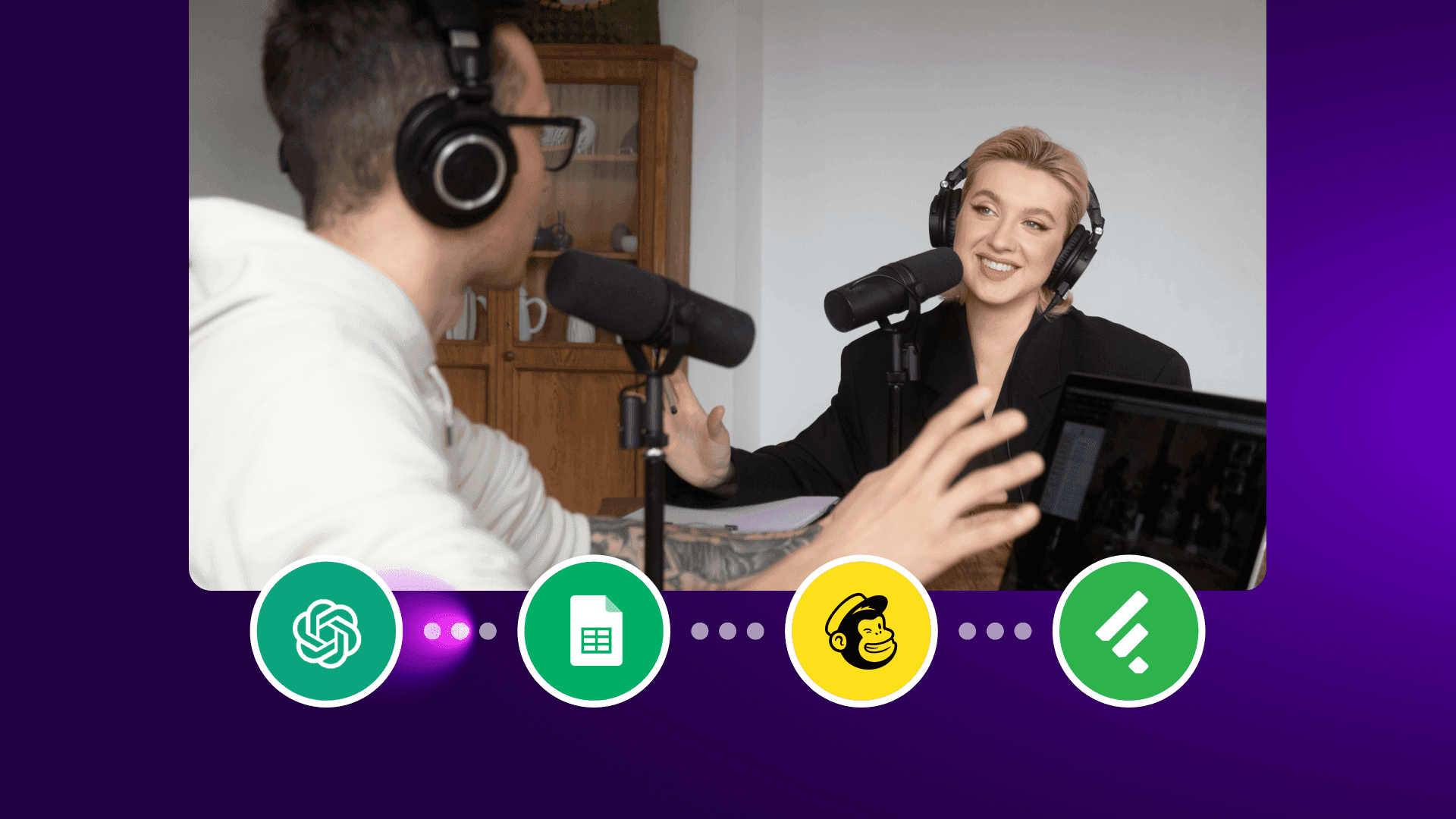May 12, 2025 | 5 minutes
How to use AI to automate newsletter and podcast creation
Many of us already use AI to help write content, but when you combine it with the automation magic of Make, it can do so much more.

In a recent free Make webinar, Ed Axe, founder of Axe Automation, shared how his team built end-to-end workflows for a newsletter and podcast using AI and Make.
This article highlights the key takeaways, tools, and steps to do it yourself.
The problem
Automation agency Axe Automation was working with a real estate company that wanted to keep in touch with its leads through a monthly newsletter.
The team was doing everything manually – finding news, writing summaries, and sending emails through Mailchimp – but it was very time consuming.
They also wanted to launch a podcast, but they didn’t have the resources to manually produce regular episodes.
The client needed a faster, more reliable way to create and share content – and, using Make, Axe Automation was able to make it happen.
Ed explains: “Creating the newsletter was taking more than eight hours every month. Some months, they didn’t have the time so skipped it entirely, which of course was bad for customer engagement. Now, the automation does everything – creating, fetching, analyzing – and it’s scalable.”
The tools
As an intuitive no-code tool, Make combines the power of automation and AI – making it easy to build fully automated workflows for newsletters and podcasts.
With thousands of free automation templates and 2,200+ apps, it’s a flexible platform that works with the tools you already use. Here’s a look at what Axe used to bring it all together:
Feedly – To pull in news articles via RSS based on specific topics
OpenAI – Used for rating article relevance and writing content
Alternatives: Claude, Mistral, Gemini, or browse our app library for others
Google Sheets – Used as a database to store rated and approved articles Alternative: Make’s Data Store, Excel, or any cloud database
Mailchimp – To send the newsletter to subscribers Alternatives: Klaviyo, ActiveCampaign, Gmail, or another email marketing tool
ElevenLabs – To convert article summaries into realistic audio for podcasts Alternative: Play.ht
Spreaker – Used to publish audio content as podcast episodes (connected via Make’s HTTP module)
The setup
Scenario 1: Newsletter automation
Axe Automation’s client needed a news-style newsletter to share Seattle-based property stories. The steps below show how to build that format but with Make, you can use AI and automation to create a range of newsletter types, such as product updates, feature launches, or industry roundups.
Here’s how to curate and summarize news articles then send a well-formatted newsletter automatically.
1. Fetch news articles
The scenario starts with a Feedly module that watches for new articles from selected feeds or categories (e.g. real estate, business). This pulls in titles, URLs, sources, and more.
2. Classify each article
An OpenAI module is triggered for each article. It asks ChatGPT to determine whether the content is "local" or "national" using this prompt:
“Please tell me if the article below is related to a local or a national news:
{{1.title}}
{{1.source.id}}
If it’s just related to one specific city or state, it should be considered local.
Just reply with local or national”
Note: The double curly brackets (e.g. {{1.title}}, {{1.source.id}}) are dynamic variables in Make. They pull in data from earlier steps in the scenario – in this case, the title and source of each news article. When the automation runs, these placeholders are replaced with real content.
3. Check if it’s location-specific
If the article is marked local, another OpenAI step checks whether it’s specifically about the location being targeted, in this case Seattle in the United States:
“Please tell me if the article below is related to a Seattle news:
{{1.title}}
{{1.source.id}}
Just reply with yes or no”
4. Rate article relevance
Next, a third OpenAI call scores the article’s impact on a scale of 1 to 5 using this structured prompt:
“I’m analyzing news articles using the standard 1 to 5 impact analysis:
1 - No impact
2 - Minor impact
3 - Moderate impact
4 - High impact
5 - Very high impact
How impactful is the news below to the Seattle Commercial Real Estate market:
{{1.title}}
{{1.source.id}}
Just reply with the number 1, 2, 3, 4 or 5.”
5. Store the results
Only articles rated 3 or above are added automatically to a Google Sheet database, which includes fields for title, source, date, location, and rating.
6. Create the newsletter
On a monthly trigger, in a separate scenario, Make fetches the top-rated articles from the past 30 days. It then uses a text aggregator (a tool available with Make’s scenario builder) to format each article’s headline and URL into a clean list, ready to be passed to OpenAI for summarizing.
7. Write summaries and intro
OpenAI is used again to:
Write brief summaries for each selected article
Generate a cohesive intro paragraph in a specific style using this prompt:
“Please write a very concise Overall Summary of the newsletter summarizing in a few sentences the content of the newsletter.
The writing style should mimic that of Marc Stiles (PSBJ), Konrad Putzier (WSJ), or broadly, Bloomberg or Forbes.”
8. Send via Mailchimp
The final content (formatted in HTML) is pushed to Mailchimp using the client’s preferred email template and sent to subscribers at a particular time (with the option for a human to proof and approve if preferred).
Catch up with the full webinar for additional detail and to get free access to Ed’s blueprints, with complete OpenAI prompts, for this entire scenario.
Scenario 2: Podcast automation
Axe Automation’s client also wanted to launch a fully automated podcast featuring an AI-generated roundup of stock market news.
The steps below walk through how to build this style of podcast, with summaries spoken using realistic voice AI – but it’s also possible to create other formats, like thought leadership segments or audio versions of your newsletter using Make and AI.
1. Use the same first steps as scenario 1
The first part of the podcast scenario is identical to the newsletter setup: fetch articles, classify them, check relevance and rate them using AI.
2. Filter top articles
This time, the goal is to pick the top 3 most impactful articles. OpenAI helps select them using this tailored prompt:
“I’m creating a podcast show and I need to select the top 3 most important news articles related to the Stock Market, from the list below:
{{11.text}}
Which 3 would you select?”
3. Write podcast-ready summaries
The next OpenAI module writes two-sentence summaries for each of the top articles, styled for business audio:
“The writing style should mimic that of Marc Stiles (PSBJ), Konrad Putzier (WSJ), or Bloomberg/Forbes.
Output should be HTML with a bold headline and normal-text summary."
4. Convert to audio
Each summary is passed to ElevenLabs, which generates a natural-sounding voiceover file from the text.
5. Publish the episode
Finally, Make sends the audio to Spreaker via the HTTP module (there’s not a native app yet), using Spreaker’s API to upload and publish the episode (again, with the option for a human to proof and approve if preferred).
Want to see more webinars from Make?
This is just one of the many webinars our team organizes alongside expert Make users with real-world use cases. Check out our dedicated webinar page to see past and upcoming sessions!
How AI helps
AI isn’t just used to generate content – it powers workflows that wouldn’t be practical (or even possible) to manage manually. Here’s how:
Smart filtering
AI classifies articles as local or national, checks relevance, and scores impact from 1 to 5. This cuts out low-value content automatically.
Content creation
AI writes clear, on-brand summaries and newsletter intros in seconds – something that used to take hours.
Voice generation for podcasts
AI tools like ElevenLabs turn written summaries into natural-sounding audio, making it possible to produce polished podcast episodes without needing a voiceover artist or recording setup.
Human-in-the-loop
For complete peace of mind, final drafts can be saved for manual review and edits before sending or publishing.
Do more with Make and AI
Learn more about AI automation with Make here and sign up for a free account to start automating today.



